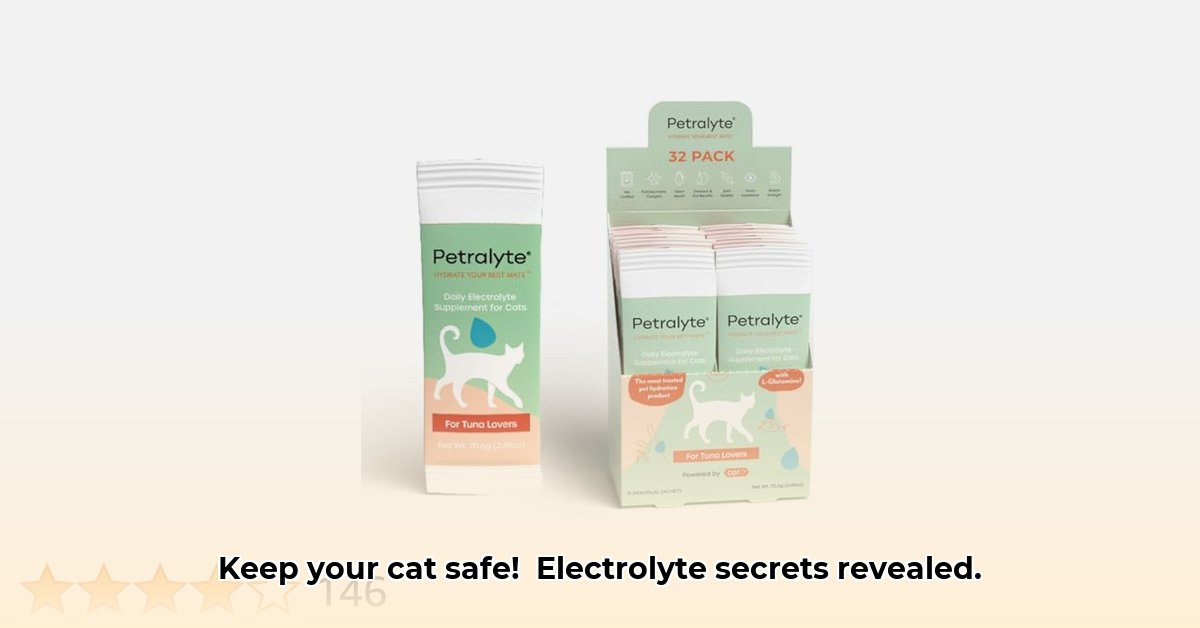Worried about your cat being dehydrated? It’s a serious concern, and knowing how to handle it can make a big difference. This article explains what electrolytes are and why they are essential for your cat’s health. We’ll show you how to recognize the signs of dehydration, when you need to rush to the vet, and how to safely give your cat electrolytes – but only if your vet approves it! We’ll cover both commercially available solutions and, with your vet’s permission, simple homemade options. We’ll also discuss ways to prevent dehydration in the first place. Remember, your vet is your best resource when it comes to your cat’s health, so always check with them before trying anything new. For more on feline illnesses, see information on common cat illnesses.
Electrolytes for Cats: A Guide to Hydration and Health
Keeping your feline companion properly hydrated is crucial for their overall health and well-being. Electrolytes play a key role in maintaining hydration. Let’s understand what they are and their importance for your cat’s health, ensuring your cat maintains optimal hydration.
Understanding Electrolytes: The Tiny Powerhouses
Electrolytes are essential minerals that help your cat’s body function correctly; think of them as tiny powerhouses. These unsung heroes of your cat’s internal systems include sodium, potassium, chloride, and calcium. These minerals work together to maintain fluid balance, power muscles, and help nerves send signals throughout the body. A shortage of these minerals can cause serious health issues in your feline friend, impacting nerve signals. Electrolytes are obtained through a balanced diet and proper hydration.
Recognizing Dehydration: Spotting the Signs Early
Early detection of dehydration is key. Look for these warning signs to catch it quickly:
- Sunken eyes: A clear indicator of fluid loss where your cat’s eyes might look hollow or less full than usual.
- Dry gums: Instead of feeling moist, your cat’s gums will feel sticky and dry.
- Lethargy and weakness: An unusually tired and sluggish cat can be a sign.
- Loss of skin elasticity (the pinch test): Gently pinch the skin on the back of your cat’s neck. Dehydration is indicated if it slowly springs back into place. If it stays in a “tent” shape, your cat is likely dehydrated.
- Constipation: A dehydrated cat’s body will try to conserve water, leading to harder stools and difficulty passing them.
- Decreased urination: A noticeable decrease in urine volume can also be a sign of dehydration.
If you notice several of these signs, it’s important to take action promptly. Monitor your cat’s water intake, offer wet food, and consult your veterinarian for the best course of action.
When to Call the Vet: Serious Signs You Shouldn’t Ignore
Some symptoms need immediate veterinary care. Do not delay if you observe any of these issues:
- Severe vomiting or diarrhea: Can lead to rapid fluid loss, quickly dehydrating your cat, as this rapid fluid loss leads to dehydration.
- Lethargy combined with other symptoms: If your cat is unusually tired and shows other signs like sunken eyes or dry gums, it’s time for a vet visit.
- Breathing difficulties: A serious sign requiring quick veterinary attention, as breathing difficulties require immediate attention.
- Complete loss of appetite: A significant red flag suggests something is seriously wrong, as a refusal to eat indicates something is amiss.
- Seizures: Dehydration can sometimes trigger seizures in cats, requiring immediate veterinary intervention.
- Unresponsiveness: If your cat is not responding to your voice or touch, it’s a critical sign of severe dehydration.
Never attempt to treat severe dehydration at home. Your veterinarian is your best resource for proper care, including intravenous fluids and addressing the underlying cause.
Commercial Electrolyte Solutions: The Safest Bet
Commercially available electrolyte solutions, specifically designed for cats, are your safest option, according to veterinary professionals. These solutions are formulated with the correct balance of electrolytes for feline physiology. Your vet can recommend a brand and help you choose the best product for your cat’s individual needs. These solutions contain a precisely balanced mix of electrolytes, minimizing risks associated with homemade options. Look for brands like Vetri-Science, Nutri-Vet, or Tomlyn, but always consult your vet first.
Pros:
- Precise electrolyte balance: Formulated for feline needs, ensuring the right levels of essential minerals.
- Veterinarian-approved: Developed and recommended by veterinary professionals, ensuring proper dosage.
- Readily available: Easy to purchase from pet stores or your vet’s office, simplifying access.
- Palatability: Often flavored to encourage cats to drink, increasing acceptance.
Cons:
- Potentially higher cost: These solutions generally cost more than making your own, due to specialized formulation.
- Artificial ingredients: Some brands may contain artificial colors or flavors, which some owners prefer to avoid.
Homemade Electrolyte Solutions: A Risky Path (Only with Vet Approval)
Making your own electrolyte solution for your cat is risky and should only be attempted under your vet’s strict supervision. Even then, it’s usually only recommended for very mild cases. Accurate proportions are crucial; incorrect ratios can be harmful to your cat, impacting their health.
Important Note: Never use human electrolyte solutions like Pedialyte on your cat without explicit instructions from your veterinarian. While unflavored Pedialyte might be considered safe in very small amounts under vet guidance, it’s not ideal due to differing electrolyte concentrations. Why is it that veterinary professionals recommend that electrolytes be formulated for cats specifically? Because cats have different metabolic needs than humans, and an imbalance can cause further health problems.
If your vet approves, they may provide a recipe. Follow their instructions precisely, and do not deviate, ensuring your feline friend maintains hydration. A typical recipe might include a specific ratio of water, salt, and sugar.
Pros:
- Potentially cost-effective: Could be cheaper if you already have the ingredients, though caution is still required.
- Ingredient control: You know exactly what’s going into the solution.
Cons:
- High risk of electrolyte imbalance: Improper ratios can be dangerous to your cat’s health, potentially leading to complications.
- Potential for toxicity: Improper ingredients or preparation can create harmful substances, posing risks.
- Requires veterinary approval: This method is not safe without professional guidance, so consult your vet.
- Difficult to administer: Cats may not find homemade solutions palatable, making administration challenging.
Administering Electrolytes: A Step-by-Step Guide
Whether your cat needs commercial or vet-approved homemade electrolyte solutions, administer them carefully, ensuring successful rehydration:
- Start with small, frequent doses: Smaller amounts given more often are better, as gradual administration is preferred. Aim for a teaspoon or two every hour.
- Closely monitor your cat: Watch for any signs of vomiting or other adverse reactions after giving them electrolytes, such as vomiting.
- Practice gradual rehydration: Gentle rehydration is key, avoiding rushing the process.
- Offer via syringe if needed: If your cat refuses to drink, use a syringe (without the needle) to gently administer the solution into their mouth.
- Ensure easy access to fresh water: Always provide fresh water alongside the electrolyte solution, allowing your cat to rehydrate naturally.
- Regular check-ins with your veterinarian: Your vet will monitor your cat’s progress and adjust the treatment as needed.
Preventing Dehydration: Proactive Steps for a Healthy Cat
Preventing dehydration is much easier than treating it. Here are some simple steps to take, promoting overall health:
- Always provide fresh water: Ensure your cat has access to plenty of clean, fresh water at all times. Change the water daily and clean the bowl regularly.
- Offer wet food: Wet food provides additional hydration, as it contains more moisture. Consider incorporating wet food into your cat’s daily diet.
- Multiple water bowls: Place multiple water bowls in different areas of your home to ensure your cat can drink conveniently, enabling easy access.
- Experiment with water enhancers: Some cats will happily drink water that has a tiny bit of tuna juice or unflavored broth added.
- Try a cat water fountain: Many cats prefer running water and will drink more from a fountain.
- Monitor water intake: Keep an eye on how much water your cat is drinking to identify potential problems early.
- Keep water away from food: Some cats prefer their water source separate from their food.
Responsible pet ownership involves understanding your cat’s health needs and seeking professional veterinary care when necessary. Your vet is your best ally in keeping your feline friend happy, healthy, and well-hydrated. “[Full Name and Title], [Position] at [Institution] recommends that cat owners provide their cats with plenty of fresh water, especially during hot weather”.
How to Safely Make Homemade Cat Electrolyte Solution
Key Takeaways:
- Dehydration is serious in cats; recognize symptoms early.
- Homemade solutions are only for mild cases, under veterinary supervision.
- Commercial options are safer and often preferred by vets.
- Preventing dehydration is crucial through proper hydration and diet.
- Never attempt how to safely make homemade cat electrolyte solution without vet approval.
- Your Perfect Bento Box Bag For Fresh And Tidy Meals - December 2, 2025
- Korean Meal Prep Made Easy For Delicious Weekday Meals - December 1, 2025
- Korean Food Meal Prep Makes Flavorful Weekday Meals Simple - November 30, 2025










